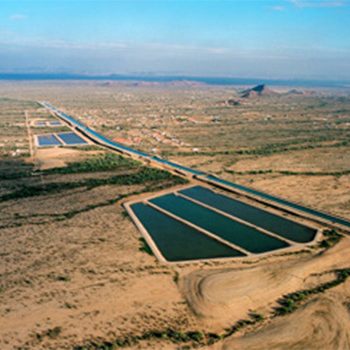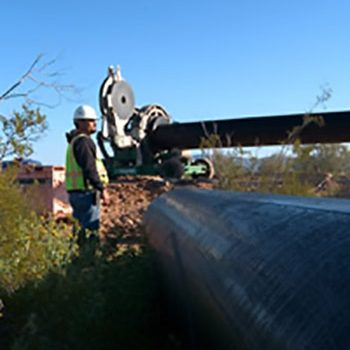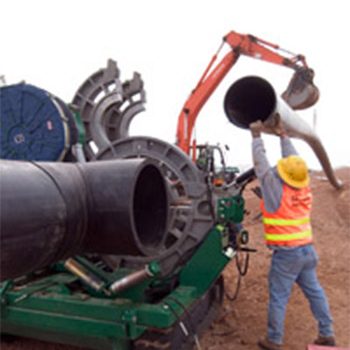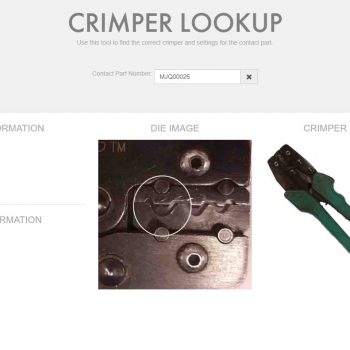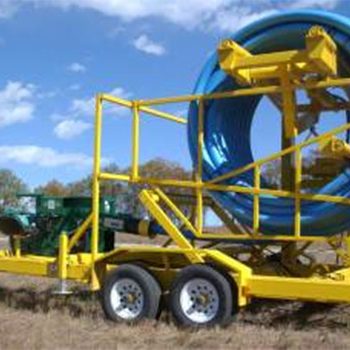Tonopah, Arizona — One of the largest water wholesalers in the country got their first taste of what a growing number of water companies in the U.S. already know — the financial bottom-line for water projects using high-density polyethylene (HDPE) is the same color as the pipe — black. That’s what officials at the Central Arizona Water Conservation District (CAWCD) discovered when they let their bid-winning contractor value engineer a 15,000-foot pipeline for the Tonopah Desert Recharge Project (TDRP).
The Tonopah Desert Recharge Project (TDRP) is part of a water conservation project developed by CAWCD, which owns a 336-mile canal that distributes Colorado River Water to a large part of Arizona. Water is taken from the canal through a gravity fed pipe system that includes 63 through 24-inch diameter HDPE pipe. The water is dumped into a series of shallow ponds that cover approximately 250 acres. From there it is allowed to seep into the ground where it eventually reaches the natural aquifer. The aquifer will act as a storage facility for future use.
HDPE was not one of the pipe options on the original bid. But when KLB Construction, Inc. told CAWCD they could do the job for $125,000 less if they were allowed to use HDPE — the pipeline owner became intrigued. When CAWCD learned from several experts in the HDPE industry that the rare maintenance occurrences with the pipe were almost always associated with third party damage, the water company jumped at the opportunity to implement the pipe.
It’s like the water industry dug up a time capsule from the 1970’s and discovered a new pipe
“It’s like the water industry dug up a time capsule from the 1970’s and discovered a new pipe,” said Steve Wilson, co-owner of High Country Fusion. He feels this project is a huge step for the pipe in water applications. “Polyethylene is being unleashed in a way that it hasn’t been in thirty years. Look at its results in the gas industry. This is a pipe that is superior to its competition both financially and physically. And water engineers are starting to figure that out the way they did in Europe during the 90’s and the way the gas industry did in the 70’s.”
Wilson is explaining how the water industry’s opinion of high-density polyethylene (HDPE) is rising after numerous success stories spread across the country. “What’s great about it is that the core benefits of HDPE haven’t really changed since it was developed in the 70’s,” he says. “The exact things HDPE has been doing for the gas industry during the last three decades — preventing leaks and saving money on installation and maintenance — is exactly what the water managers are trying to achieve. They know what their needs are and they’re talking to the HDPE industry because we have the answer.”
HDPE’s achievements over the last few years look more like it’s walking on water than transporting it. High profile potable water jobs are popping up all over the country and whole cities are converting to the pipe material. Many cities like St Petersburg, Jacksonville, Indianapolis, Louisville and Colorado Springs have adopted the pipe on a large scale and a slew of other water companies are allowing it into their specifications. Now the Federal and State Governments are discovering its abilities and using it on several pilot projects across the country. Wilson feels these high profile jobs are ultimately making his job easier.
High Country Fusion supplied the HDPE pipe and McElroy Fusion equipment for the project. Of particular concern was the complexity of fusing 63″ OD pipe. The contractor used a McElroy 2065 with a DataLogger that records the fusion procedures for each fusion joint. “The use of HDPE is the first step for one of the largest water suppliers in the West,” said Wilson. “Now that engineers are starting to understand that there can be up-front savings, along with the long term savings associated with HDPE, we’re starting to see a lot more of it being used.”
Water is rapidly becoming the hottest commodity in the West where the longest drought in recorded history continues to cause problems for water managers. Many of the problems are associated with piping infrastructure that has a leak rate estimated at 15% to 25%. The West cannot afford this kind of waste but the immense uncertainty hanging over piping infrastructure is more about the money.
In 2001 the Environmental Protection Agency (EPA) released a survey and concluded that $151 billion would be needed over 20 years to repair the nations water systems and protect public health. A year later, the agency issued The Clean Water and Drinking Water Infrastructure Gap Analysis, which said the 20-year funding gap was $161 billion — a $10 billion increase from the 2001 estimate. The Congressional Budget Office (CBO) concluded in 2003 that “current funding from all levels of government and current revenues generated from ratepayers will not be sufficient to meet the nation’s future demand for water infrastructure.” Despite this, Federal funding over the last several years reached less than 10 % of the amount needed for water and wastewater. In 2005, Congress cut funding for wastewater management and the Bush administration has proposed another 33% reduction for 2006.
The American Society of Civil Engineers feels clean and safe water is no less a national priority than are national defense, interstate highways, and the aviation system. These other infrastructure programs receive sustainable, long-term federal grant programs; under current policy, water and wastewater infrastructure do not. The current federal budget process does not differentiate between expenditures for current consumption and long-term investment. This causes major inefficiencies in the planning, design and construction process for long-term investments. A capital budget system would help Congress to focus on programs devoted to long-term results. This is where HDPE has a distinct advantage over other piping materials and why CAWCD decided to use the pipe.
“We have to conserve and watch our water,” said Francom Engineering Resources Supervisor for CAWCD. “Projects like this will secure the future of Arizona and getting people familiar with HDPE certainly makes it easier to utilize the pipe on future projects. We know that we are not going to have long term maintenance problems with the pipe, it’s a bury it, and forget about it type of pipe.”
The HDPE industry has been preaching the “long life / leak free” sermon for years, but until lately the majority of water managers have been slow to change from traditional methods and materials. Wilson says that most engineers are quick to note that by laying a new DI or PVC pipeline, a practically leak free system can be achieved as well. It is the “new” that is the important bit. And Wilson tries to point out that HDPE will not suffer an increase in leakage in the future. “The big savings come from not having leaks and huge maintenance expenses over the next 50 to 100 years,” he says. Mechanical joints will start to experience problems, sometimes in the first few years, and these troubles grow as the system ages. “Most water companies have an enormous maintenance budget,” says Wilson. “These expenses will eventually be eliminated with the exception of third party damage.”
There is no question that there is financial payback in using a leak-free, maintenance-free system. But the long-term life-cycle cost savings is a tough sell to most municipalities who are fighting for every scrap of the yearly budget and are pressured to show returns on a much shorter timescale. All involved, the idea of changing piping material is the biggest decision an engineer may make in his career. He or she will have to rewrite specifications, buy or rent fusion equipment, train employees and take on a brand new educational project while there is almost no personal reward for taking the huge step. Engineers are not paid exponentially on the amount of money and water they save the city. All of these issues go right on top of shouldering the perceived risk of using a “new” piping material. The attitude many times is that it is better to err on the side caution.
When you look at the history of HDPE in the gas industry and U.K. water industry, and hear experts like Wilson call it the best piping system in the world, you begin to realize what a remarkable accomplishment it has made for these industries.
For example, the Water Resource Council, which is responsible for all of the Water Industry Standards in the UK, recommends it so strongly that an estimated 85% of water jobs in the UK utilize it. They have determined that HDPE pipe systems always have the lowest installed cost in sizes up to 315mm (12-inches). When considering trenchless applications, the savings are even greater. The gas industry went through the same learning curve in the 1970’s but by the late 1980’s, polyethylene was regarded as a proven, maintenance free and cost-effective means of delivering natural gas to homes and businesses. It is now used in 90% of gas line applications. A growing number of success stories are starting to make the water industry wake up and smell the money, and the upfront costs and extra work associated with HDPE are starting to be overshadowed by the long-term savings and water conservation.
“If other water companies start taking a cue from organizations like (CAWCD), HDPE could become a major solution to both the financial and water shortage problems,” said Wilson. “We know HDPE will last 50 to 100 years without leaking and we sometimes wonder why people would want to build a water pipeline that doesn’t achieve the level that HDPE provides.”
